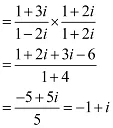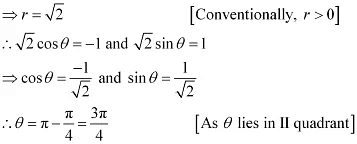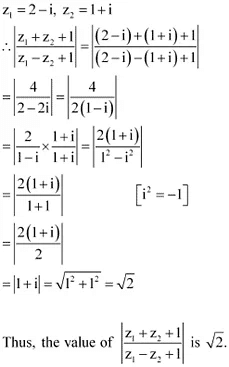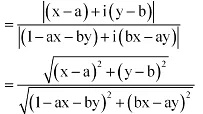NCERT Solutions Class 11 Maths Chapter 4 - Complex Numbers and Quadratic Equations
Question 1: Evaluate: 
Answer:

Question 2: For any two complex numbers z1 and z2, prove that
Re (z1z2) = Re z1 Re z2 – Im z1 Im z2
Answer:

Question 3: Reduce  to the standard form.
to the standard form.
Answer:

 [ On Multiplying numerator and denomunator by (14 + 5i)
[ On Multiplying numerator and denomunator by (14 + 5i)

Question 4: If x – iy =  prove that
prove that  .
.
Answer:
 [ On Multiplying numerator and denomunator by (c + id)]
[ On Multiplying numerator and denomunator by (c + id)]


Question 5: Convert the following in the polar form:
(i)  ,
,
(ii) 
Answer:
(i) Here, 

Let r cos θ = –1 and r sin θ = 1
On squaring and adding, we obtain
r2 (cos2 θ + sin2 θ) = 1+ 1
⇒ r2 (cos2 θ + sin2 θ) = 2
⇒ r2 = 2 [cos2 θ + sin2 θ = 1]

∴z = r cos θ + i r sin θ

This is the required polar form.
(ii) Here, 

Let r cos θ = –1 and r sin θ = 1
On squaring and adding, we obtain
r2 (cos2 θ + sin2 θ) = 1+ 1
⇒r2 (cos2 θ +sin2 θ) = 2
⇒ r2 = 2 [cos2 θ + sin2 θ = 1]

∴z = r cos θ + i r sin θ

This is the required polar form.
Question 6: Solve the equation

Answer:
The given quadratic equation is 
This equation can also be written as 
On comparing this equation with ax2 + bx + c = 0, we obtain
a = 9, b = –12, and c = 20
Therefore, the discriminant of the given equation is
D = b2 – 4ac = (–12)2 – 4 × 9 × 20 = 144 – 720 = –576
Therefore, the required solutions are

Question 7: Solve the equation 
Answer:
The given quadratic equation is 
This equation can also be written as 
On comparing this equation with ax2 + bx + c = 0, we obtain
a = 2, b = –4, and c = 3
Therefore, the discriminant of the given equation is
D = b2 – 4ac = (–4)2 – 4 × 2 × 3 = 16 – 24 = –8
Therefore, the required solutions are

Question 8: Solve the equation 27x2 – 10x + 1 = 0
Answer:
The given quadratic equation is 27x2 – 10x + 1 = 0
On comparing the given equation with ax2 + bx + c = 0, we obtain
a = 27, b = –10, and c = 1
Therefore, the discriminant of the given equation is
D = b2 – 4ac = (–10)2 – 4 × 27 × 1 = 100 – 108 = –8
Therefore, the required solutions are

Question 9: Solve the equation 21x2 – 28x + 10 = 0
Answer:
The given quadratic equation is 21x2 – 28x + 10 = 0
On comparing the given equation with ax2 + bx + c = 0, we obtain
a = 21, b = –28, and c = 10
Therefore, the discriminant of the given equation is
D = b2 – 4ac = (–28)2 – 4 × 21 × 10 = 784 – 840 = –56
Therefore, the required solutions are

Question 9: If  find
find  .
.
Answer:

Question 10: If a + ib =  , prove that a2 + b2 =
, prove that a2 + b2 = 
Answer:

On comparing real and imaginary parts, we obtain

Hence, proved.
Question 10: Let  . Find
. Find
(i)  ,
,
(ii) 
Answer:

(i) 

On multiplying numerator and denominator by (2 – i), we obtain

On comparing real parts, we obtain

(ii) 
On comparing imaginary parts, we obtain

Question 11: Find the modulus and argument of the complex number  .
.
Answer:
Let  , then
, then

On squaring and adding, we obtain


Therefore, the modulus and argument of the given complex number are  respectively.
respectively.
Question 12: Find the real numbers x and y if (x – iy) (3+5i) is the conjugate of –6 – 24i.
Answer:
Let 

It is given that, 

Equating real and imaginary parts, we obtain

Multiplying equation (i) by 3 and equation (ii) by 5 and then adding them, we obtain

Putting the value of x in equation (i), we obtain

Thus, the values of x and y are 3 and –3 respectively.
Question 13: Find the modulus of  .
.
Answer:

Question 14: If (x + iy)3 = u + iv, then show that  .
.
Answer:

On equating real and imaginary parts, we obtain

Hence, proved.
Question 15: If α and β are different complex numbers with  = 1, then find
= 1, then find  .
.
Answer:
Let α = a + ib and β = x + iy
It is given that, 






Question 16: Find the number of non-zero integral solutions of the equation  .
.
Answer:

Thus, 0 is the only integral solution of the given equation. Therefore, the number of non-zero integral solutions of the given equation is 0.
Question 17: If (a + ib) (c + id) (e + if) (g + ih) = A + iB, then show that
(a2 + b2) (c2+ d2) (e2 + f2) (g2 + h2) = A2 +B2.
Answer:


On squaring both sides, we obtain
(a2 + b2) (c2 + d2) (e2 + f2) (g2 + h2) = A2 + B2
Hence, proved.
Question 18: If  , then find the least positive integral value of m.
, then find the least positive integral value of m.
Answer:

Therefore, the least positive integer is 1.
Thus, the least positive integral value of m is 4 (= 4 × 1).
|
80 videos|315 docs|99 tests
|
















